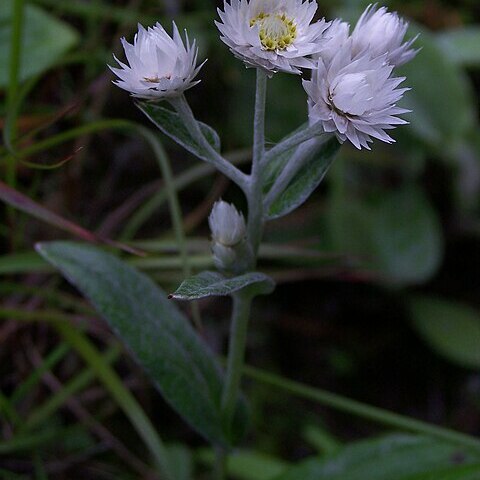Herbs, perennial. Rhizome slender or slightly robust, runners ca. 20 cm, rarely ca. 40 cm; leaves of runner obovate or spatulate, 1-2 cm, with terminal rosette leaves. Stems erect or ascending, 4-45 cm (or plants acaulescent), white tomentose, densely or sparsely leafy. Lower leaves persistent during efflorescence, rarely withered, homomorphic with rosette leaves, spatulate, oblanceolate, or oblong-oblanceolate, 1-7 × 0.5-2 cm or larger, base attenuate, margin flat, apex rounded or acute; middle leaves oblong or oblanceolate, often rather narrow, base amplexicaul, sessile, apex obtuse or acute, with acerose cusp; upper leaves attenuate; or short stems without middle and upper leaves; all leaves white tomentose or cauliferous glandular pilose on both surfaces or abaxially, (1 or)3-veined. Capitula solitary or few, rarely numerous, sparsely corymbiform; peduncle 0.5-2.5 cm. Involucre somewhat spherical, 8-12 × 15-20 mm, exceeding disk; phyllaries 8-or 9-seriate, radiate in efflorescence; outer phyllaries puce except at apex, oval or lanceolate, 3-3.5 mm; middle ones white, lanceolate, 7-10 × 2.5-3 mm, acute at apex; innermost ones linear-lanceolate, 5-8 mm, with a claw ca. 1/3 of full length. Receptacle lacunose. Predominantly female capitula with numerous marginal female florets, center with 3-6 male florets; predominantly male capitula with male florets only, or 1-3 female florets outside. Corolla of male florets ca. 3 mm, ca. 4 mm in female florets. Pappus ca. 4 mm, incrassate at tip of apex in male florets, serrulate. Achenes terete, ca. 1 mm, hirsutulous. Fl. Jun-Sep, fr. Aug-Oct.
More
A herb. It keeps growing from year to year. It has a slender rhizome. The runners can be 20 cm long. The leaves on the runners are oval or spoon shaped. There is a ring of leaves at the end. The stems are 4-45 cm tall. They have a white coating. The flowers are in daisy like heads with white and a yellow centre.
It is a temperate plant. It grows in cold desert in north India in the Himalayas. In China it grows in alpine grasslands and pine forests between 2,400-4,500 m above sea level. In Sichuan and Yunnan.

